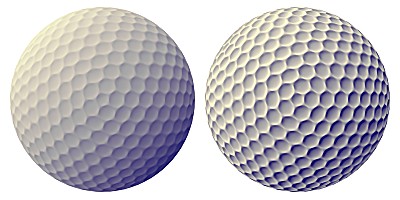Exaggerated Shading for Depicting Shape and Detail
ACM Transactions on Graphics (Proc. SIGGRAPH), July 2006

Simple diffuse lighting (left) results in lower contrast in the
upper-left and lower-right regions of this golf ball, where the surface
is facing towards or away from the light. Our proposed exaggerated
shading (right) brings out detail throughout the surface by locally
moving the light direction to be grazing with respect to the surface.
Abstract
In fields ranging from technical illustration to mapmaking, artists have
developed distinctive visual styles designed to convey both detail and
overall shape as clearly as possible. We investigate a non-photorealistic
shading model, inspired by techniques for cartographic terrain relief,
based on dynamically adjusting the effective light position for
different areas of the surface. It reveals detail regardless of surface
orientation and, by operating at multiple scales, is designed to convey
detail at all frequencies simultaneously.
Paper
Supplementary Material
Talk
Source Code
- "Xshade": downloadable source and binaries
Citation
Szymon Rusinkiewicz, Michael Burns, and Doug DeCarlo.
"Exaggerated Shading for Depicting Shape and Detail."
ACM Transactions on Graphics (Proc. SIGGRAPH) 25(3), July 2006.
BibTeX
@article{Rusinkiewicz:2006:ESF,
author = "Szymon Rusinkiewicz and Michael Burns and Doug DeCarlo",
title = "Exaggerated Shading for Depicting Shape and Detail",
journal = "ACM Transactions on Graphics (Proc. SIGGRAPH)",
year = "2006",
month = jul,
volume = "25",
number = "3"
}